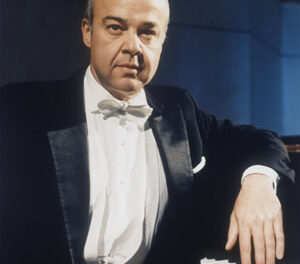Word about the Duke Symphony Orchestra is getting out, and more and more people are attending concerts presented by the now-85-member ensemble, directed by Harry Davidson. The Maestro is in his sixth season of building and rebuilding, and his efforts show in the increasingly strong performances of the group. For the last event of the season, given in Baldwin Auditorium on April 13, the bill of fare consisted of Bartók’s Roumanian Folk Dances, the first movement of Tchaikovsky’s Violin Concerto, and Dvorák’s “New World” Symphony. The theme – Davidson is a “title man” – was “Inspired Influences: from the Old World to New (and back again).” The larger-than-usual program booklet, augmented this time by short statements from the orchestra’s ten(!) graduating seniors*, didn’t tell us the meaning of the title, but it will be clear to many readers: all three “Old World” composers spent at least short periods of time in America.
This is now one of our region’s largest orchestras. It has enough strings to balance the winds, brasses, and percussion, except (as someone said) when they get carried away – and they didn’t do that very often. There were some minor splats and cracks and several little ensemble lapses here and there, but overall the sound was solid, unified, well-blended, and impressive. This was especially true in the six little Bartók numbers, which are short but rhythmically tricky showpieces of the first magnitude. Davidson introduced some nice interpretive touches, so the results suggested the real McCoy – or at least the sort of thing one used to be able to hear in ethnic dives when ethnic dives still hired live musicians to serenade their customers.
Tchaikovsky’s Violin Concerto is one of the mainstays of the repertoire, one that some might call a warhorse, but we won’t here, because it’s such a great work and because it no longer turns up with the frequency it once did. One of Duke’s great scholars mentioned at intermission the influence of the Heifetz recording on him, in his early years, prompting the question, Which one? (The mono version conducted by Susskind has always seemed preferable to Reiner’s, for this writer.) This led to a discussion of the technical and artistic prowess of the evening’s soloist, Rahul Satija, a junior who is in his second year as concertmaster. It’s a fact that he played like a master with many more years of experience than he’s had, at the ripe old age of 19. The orchestra provided solid support, and the performance was good enough to make one wish it had gone on, rather than ending after the first movement. (One reason the sound was so good –and the balance, too – is that Satija was forward on the stage, in front of the orchestra and virtually parallel to the conductor. It made a big difference in audibility, in the hall.)
After the concerto movement, Satija invited his stand-partner and friend Ian Han to join him for a performance of his duet arrangement of the Tango (“Por una Cabeza”) from Thomas Newman’s Scent of a Woman that brought down the house, as the saying goes.
Dvorák’s Ninth Symphony (which used to be known as No. 5…) is another piece with “warhorse” status, one that many seasoned classical music vets – on both sides of the footlights – surely cringe to see listed, never mind to hear…. Still, as a NY Times critic noted a while back, at every concert, there are people hearing – or playing – a given composition for the very first time – and people who are hearing – or playing – it for the very last time. Chances are good that this was a first encounter with Dvorák’s magnum opus for many of the musicians, and this showed in levels of attention and excitement that were palpable. Davidson has brought the orchestra a long, long way, and he doesn’t need to coddle folks with slower-than-usual tempi any more. This performance, conducted from memory, breezed along where it needed to, looked inwardly in the reflective sections, and seemed all of a piece from start to finish. (There’s architecture in Dvorák’s constructions, so it really does matter that the work wasn’t four separate and distinct chunks, tacked together.)
Before the “New World,” the orchestra presented a large “thank you” card to its leader – it looked a bit like the product of a kindergarten class, with “Maestro” in a rainbow of colors on the cover, and it was signed by all the players. In truth, these undertakings are joint, cooperative and collaborative efforts. The substantial audience gave the artists a well-deserved ovation, and people went away to ponder how Davidson will get ten replacements and whip the new group back into comparable shape next year. Ah, the delights of conducting… and of teaching!
*The ten seniors are Jon Carter, Ian Han (author of many fine Duke SO program notes), T.J. Pineda, Ek-han Tan, T.J. Yin, & Sarah Zaman, violins; Michelle Mangan (co-principal) & Garrett Casto, violas; Nathan Sherrard, horn; & Bina Vasantharam, bassoon.











